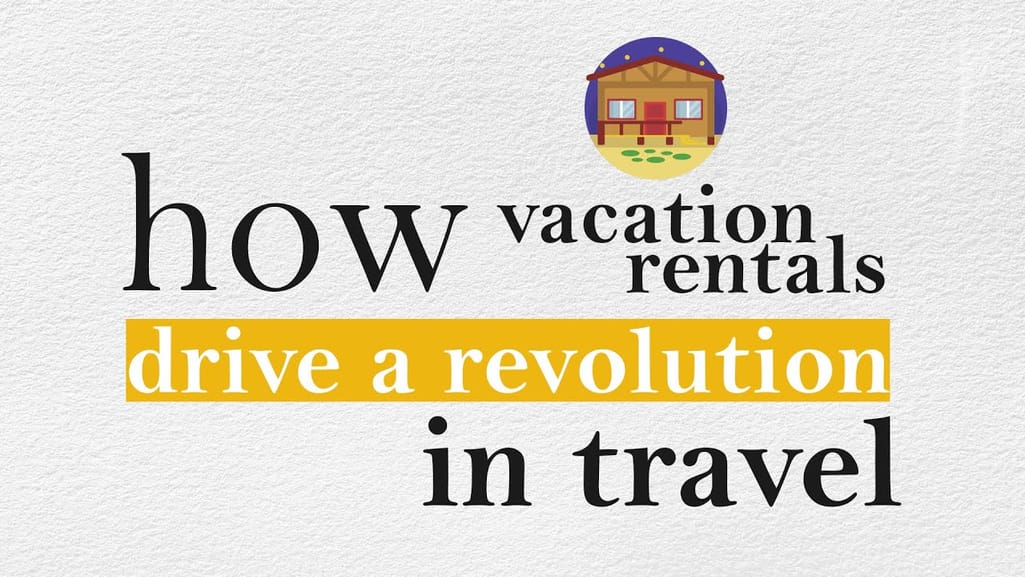

Vacation rentals, explained
By offering competitive pricing and a home-like setting, vacation rental properties are gaining more and more popularity. To manage this sort of business smoothly and effectively, property owners and managers will need feature-rich vacation rentals software with API integrations in place.
In this post, we’ll explain what vacation rental property management software is, the modules it consists of, how it integrates with various booking platforms, the popular solutions to consider, and much more.
What is vacation rental software?
Vacation rental software (also referred to as a vacation rental property management system or vacation rental PMS) is a centralized system that allows hosts and private property owners to carry out all their reservations and administrative tasks for short-term rental facilities online. Similar to its sibling — hotel property management systems — vacation rental software enables the complete sync-up of all your properties and accounts in real-time while automating many day-to-day operations.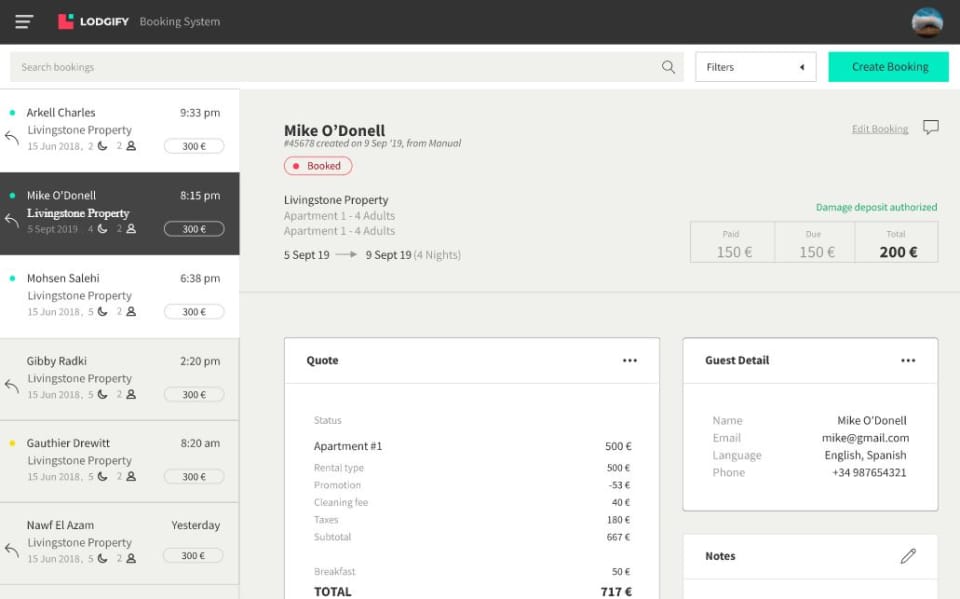
The look of vacation rental software. Source: Lodgify
You may be a multi-property manager with rental listings across multiple online travel agencies (OTAs) like Booking.com and Expedia. Or you may own just a few housing units and rent them out on Airbnb. Whatever the case, taking care of property management isn't a piece of cake. That’s why you may opt for vacation rental software as it facilitates many things from centrally controlling communication with guests to conveniently managing payments and reservations.
The reality is that property management systems are among the most widely adopted vacation rental software solutions, according to the Rentals Unites report. As you can see, only 19 percent of those owning or managing a short-term rental facility still don’t use a PMS. And among those who have tamed this tech beast, most prefer using third-party tools to the custom-built.
The adoption of property management systems by vacation rental owners
To understand how this software works, let’s look at its most common functionality modules.
Key features of vacation rental software
A typical vacation rental PMS combines different functions within a unified software environment. Based on the provider, modules and the scope of their functionality may vary greatly. Besides, some modules, including the ones listed here, often come as individual third-party integrations to a solution.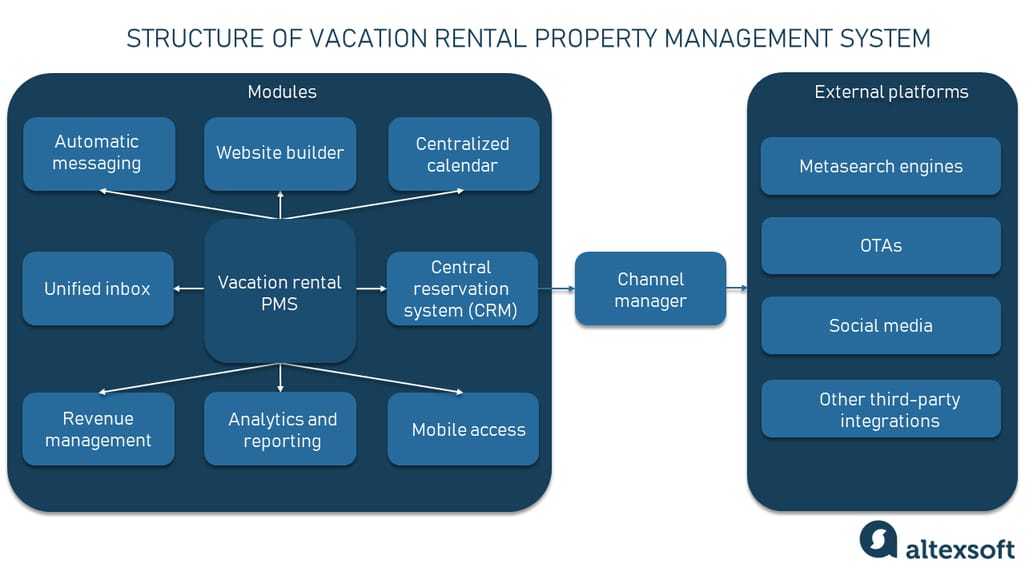
Structure of a vacation rental property management system
Below we detail the main building blocks of vacation rental software for you to consider.
Reservation management
The reservation module is the cornerstone of any vacation rental software enabling users to manage online and offline bookings. Also known as a central reservation system (CRS), the module tracks data regarding the availability of inventory, pricing details, dates, and other important reservation information. The technology can be a stand-alone solution integrated with the existing PMS or be available as its functional part. A CRS works in tandem with the channel manager, which we explain below, to distribute data about rentals to different booking channels, synchronize reservations, and process payments.
Automatic messaging
Your guests won’t want to live in an information vacuum. To prevent that, there’s a special module many vacation rental property management systems offer — automatic messaging and scheduling. With this tool in place, you can set up automatic confirmation emails to send to guests right after they made a reservation. Or they can be friendly reminders of the upcoming trip, review inquiry, arrival instructions, and departure checklist, to name a few.
Unified inbox
Some providers offer a tool that integrates all communication with guests in one inbox.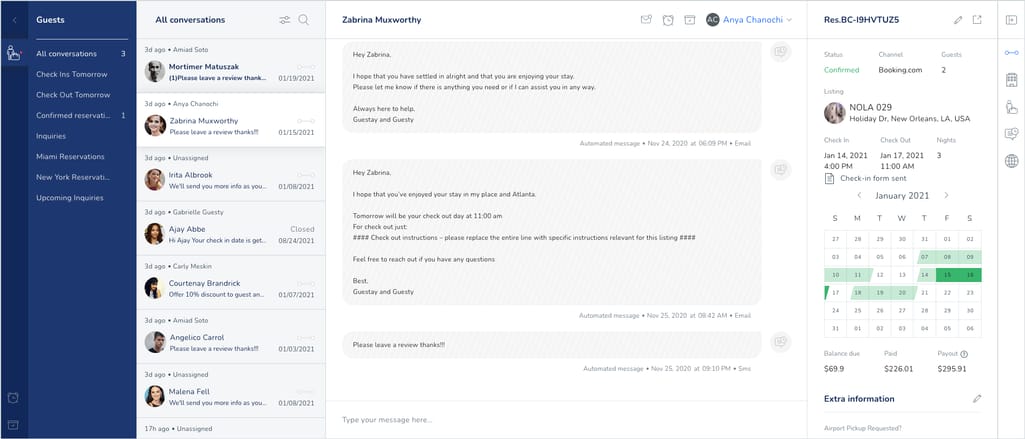
Unified inbox dashboard. Source: Guesty
This feature provides you with a unified view of the messages coming from multiple, distributed systems. These can be emails, inbox features of different booking channels, or even SMS. So, instead of logging into all these platforms to keep up with guest inquiries and respond quickly, you have all conversation threads in one place. The module can be equipped with the functionality to filter messages, resurface those waiting for a response, and more.
Channel manager
Connected to a central reservation system explained above, the channel manager module provides a single interface to enable the distribution of rental inventory with instant price and availability updates across multiple sales channels. While a channel manager can be a stand-alone solution, it is often integrated as a part of a vacation rental property management system.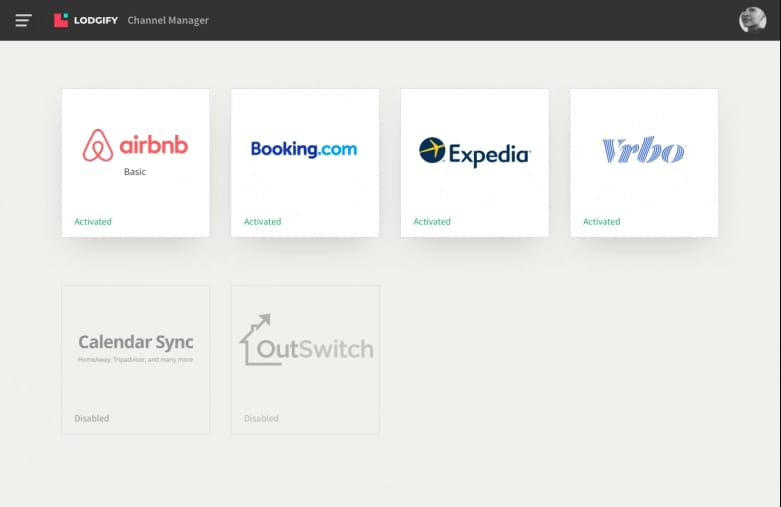
Channel Manager dashboard. Source: Lodgify
As a rule, this software module connects to such channels as OTAs, metasearch engines, websites, and social media, etc. It shares property availability and cost information with all integrated platforms and imports back the reservations made there. In this way, guests always see the actual picture of property occupancy and you avoid double bookings.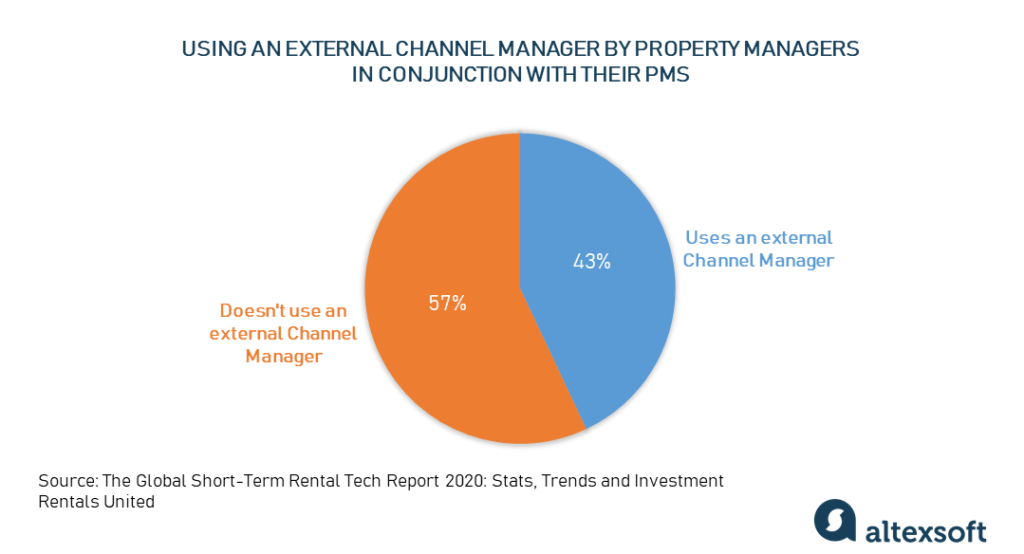
Chart showing the use of external Channel Managers
Most vacation rental PMSs have their own channel managers integrated as a part of the whole system. They are easy to set up and run but may be limited in terms of functionality.
So, if you see that the one you have in place doesn’t provide what you need, you can acquire a channel manager separately as a stand-alone solution. We have a dedicated article exploring popular vacation rental channel managers.
Centralized calendar
A centralized calendar (or multi-calendar) is a module that keeps track of all past, current, and upcoming reservations no matter where they are made, and presents them in a single, unified view. It allows updating rental reservation information across different booking channels automatically. If one property unit is reserved on Airbnb, for example, the calendar will present that information to other individual calendars so that the unit can be blocked for booking.
Analytics and reporting
Another useful feature to be included in vacation rental software is the ability to take property and booking data and turn it into actionable business insights. Many software providers offer built-in reporting and analytics tools for this purpose. Raw business data such as revenue per rental, occupancy rates, seasonality, etc., can be organized into detailed reports with key metrics to help you understand how your vacation rentals perform. As such, you can rethink your business strategies as well as determine weaknesses and strengths.
Revenue management
While most off-the-shelf vacation rental solutions don't provide revenue management features out of the box, the module is a must-have in today’s travel and hospitality industry. A revenue management system analyzes data such as historical rental rates, competitor rates, market dynamics, and inventory levels to forecast demand and provide rate recommendations for your rentals. Driven by machine learning technology, such systems can take into account thousands of different factors — both internal and external — that influence pricing and demand. As a result, you can efficiently react to changes and adjust to them.
In one of the recent projects, the AltexSoft team helped a US-based business intelligence company providing performance data insights for small- and medium-size vacation rentals to develop an AI-powered feature that forecasts occupancy rates in rentals. You can find out more in our case study.
Website builder and mobile access
Leading providers of vacation rental software enable clients to build their own branded website with a booking engine giving them the opportunity to enter direct reservations (independent of any OTAs). Along with the website, the toolset of a short-term property management system should be available via a mobile application. Enabling remote work makes this building block significant aid for owners and hosts.
Third-party integrations
The functionality of your vacation rental PMS can be greatly expanded with a library of integrations. These can be application programming interfaces (APIs) to connect to payment processing solutions, keyless access systems, dynamic pricing tools, and a bunch of other integration options.
Of course, there are plenty of other features that may play a crucial role in a particular business use case. Moreover, unique tasks may require the custom development of vacation rental software.
Not to mention that a convenience like a vacation rental PMS doesn’t come for free. Most providers offer two pricing plans: a fixed price and a commission-based rate.
The fixed price is a set fee a client must pay at the end of each month and it doesn’t fluctuate with the number of reservations. With it, you pay a fixed fee per property per month and sometimes per booking channel. The commission rate charges you per reservation each month. In some cases, these two pricing plans can be combined.
Popular vacation rental property management systems
If you go on the Internet searching for short-term rental software tools, you’ll find them in abundant supply, each offering a distinctive set of features to optimize and automate your work processes. Some vendors sell off-the-shelf packages while others offer customization services based on business scale and focus. We’ve picked a few popular solutions that may be worth your attention.
Please note that this list is for guidance only: We do not promote any vacation rental software providers.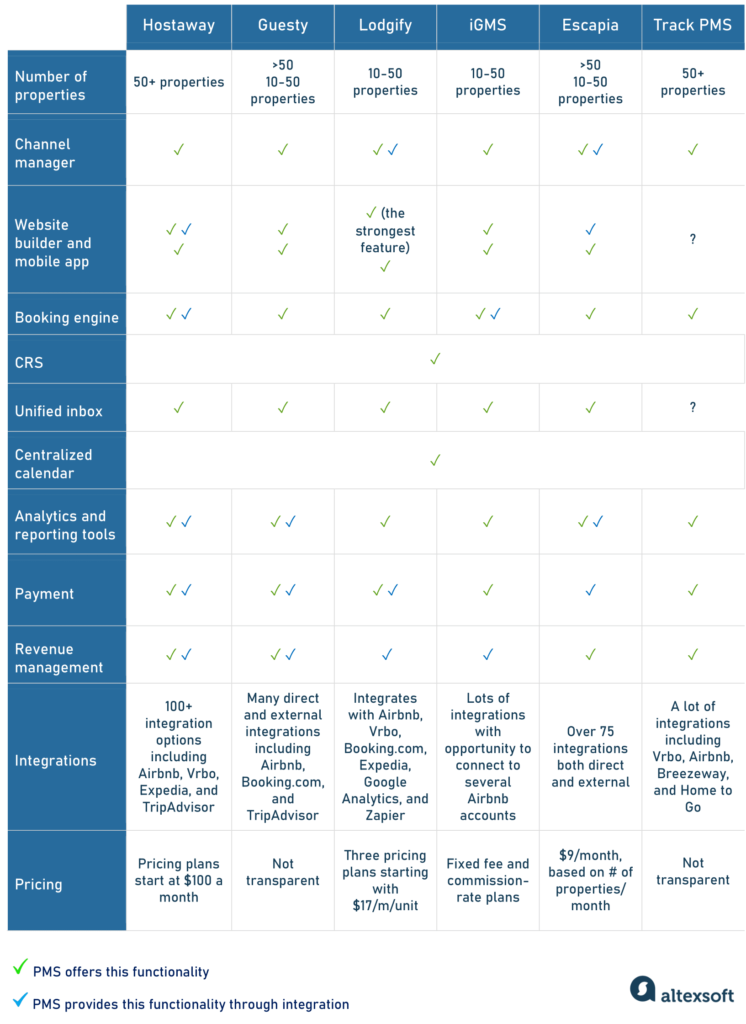
Vacation rental software comparison table
Hostaway: Vast integrations list and scalable inventory
Hostaway is an end-to-end rental property management platform aimed at streamlining the day-to-day operations of short-term rental hosts or property managers. The company claims that its software has what it takes to scale to whatever number of properties you manage or plan to manage — whether there are 5 units or 20,000. The functionality is available via a web dashboard and a mobile app. Many users admit that the platform has top-notch 24/7 support.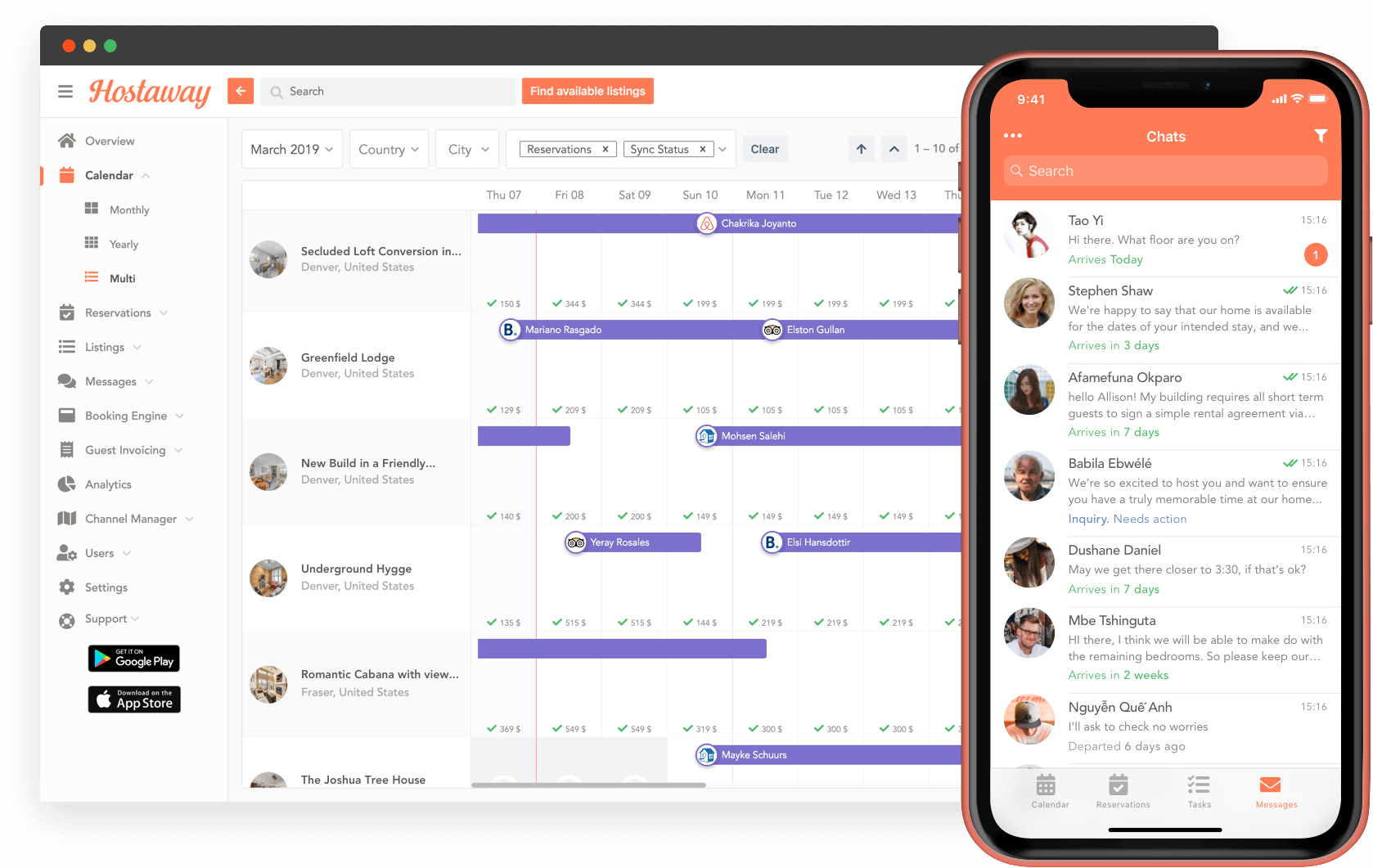
Hostaway dashboard and mobile app
Features: From automated messages and a unified inbox to financial reporting and advanced analytics, the set of features within the Hostaway environment is impressive. Its modules cover pretty much every aspect of vacation rental management. Some of the distinguishing features include revenue management and cross-listings (when some units that are close to one another can be combined or rented out individually depending on the booking situation).
Integrations: In addition to the basic set of rental property management features, Hostaway integrates with over 100 software tools in the vacation rental industry to bring more functionality to the table. The list includes Airbnb, Vrbo, Expedia, and Tripadvisor, to name a few. More than 3,000 additional connections are available with the Zapier product. Moreover, Hostaway offers its own open API for building custom connections.
Pricing: With pricing plans starting at $100 a month, Hostaway takes into account the unique needs of each business, offering customized pricing.
Best for: Any property owners and hosts that want to manage different aspects of the vacation rental business with one software platform and appreciate timely tech support.
Guesty: Feature-rich and user-friendly platform
One of the most well-known solutions, Guesty is an all-in-one property management platform packed with all the standard features needed to run a vacation rental business with ease.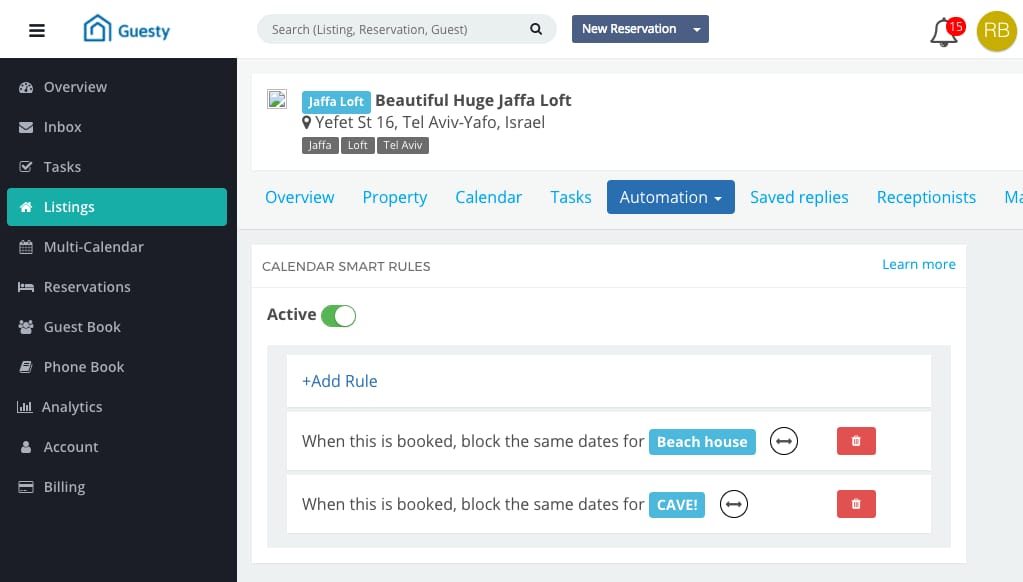
Guesty smart calendar feature
Features: Guesty provides an exhaustive collection of standard features for property management, including a channel manager, multi-calendar, messaging, payment processing, and reporting tools. The system enables creating multiple user accounts with various access levels as well as handling all listing maintenance from a single dashboard. With Guesty, you can also build your own website and take advantage of a mobile application.
Integrations: Your Guesty account can be easily synced with various booking channels, management platforms, and other services. These integrations can be found and activated on the provider marketplace. There’s also an open API you can use to connect other external tools and services.
Pricing: You can ask for a quote and get the pricing that is custom-tailored to the needs of your business. Usually, Guesty charges a commission per each booking with the commission dependent on the number of listings you have. The more listings there are, the lower your fees.
Best for: The solution suits short-term rental managers and owners running 5+ property units and eager to have all the features under the hood of one platform.
Lodgify: Vacation rental software with a great website builder
Spain-based, Lodgify is another worthy vacation rental software on the list. Simplifying property management, the solution is one of those that can scale with your business.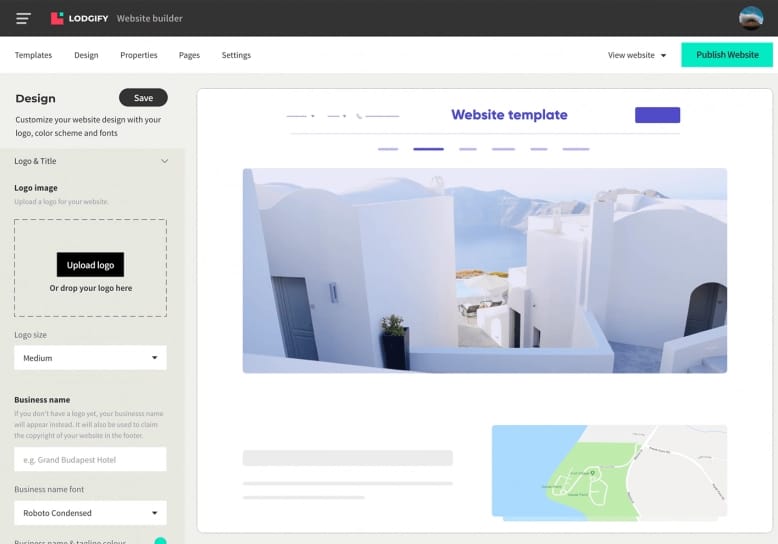
Lodgify website builder
Features: Lodgify contains all the core modules to carry out rental reservation and operational tasks, including multi-calendar, payment processing, channel manager, and many more. The platform is famous for its website builder containing templates and widgets to quickly set up what you need. Lodgify comes with an integrated booking engine for direct reservations.
Integrations: The platform provides direct connections to major listing channels in the vacation rental industry like Booking.com, Airbnb, and Expedia, synchronizing both property cost and availability. Owners running more than 5 properties can also have a direct integration with Vrbo. Other external platforms can be reached with the help of iCal integrations that coordinate bookings and availability but not pricing. There are also free integrations with Google Analytics and Zapier.
Pricing: You can choose from three pricing plans: Starter ($17 per month with 1.9 percent booking fee), Professional ($46 per month, no booking fee), and Ultimate ($69 per month, no booking fee). These prices are for one rental unit.
Best for: Lodgify is a good fit for both newcomers and those who have been in the vacation rental business for a while.
iGMS: Rental PMS perfect for Airbnb users
Previously known as AirGMS, iGMS is a unified property management platform for streamlining calendar sync-up, guest communication, cleaning, and other daily operations of rental owners.
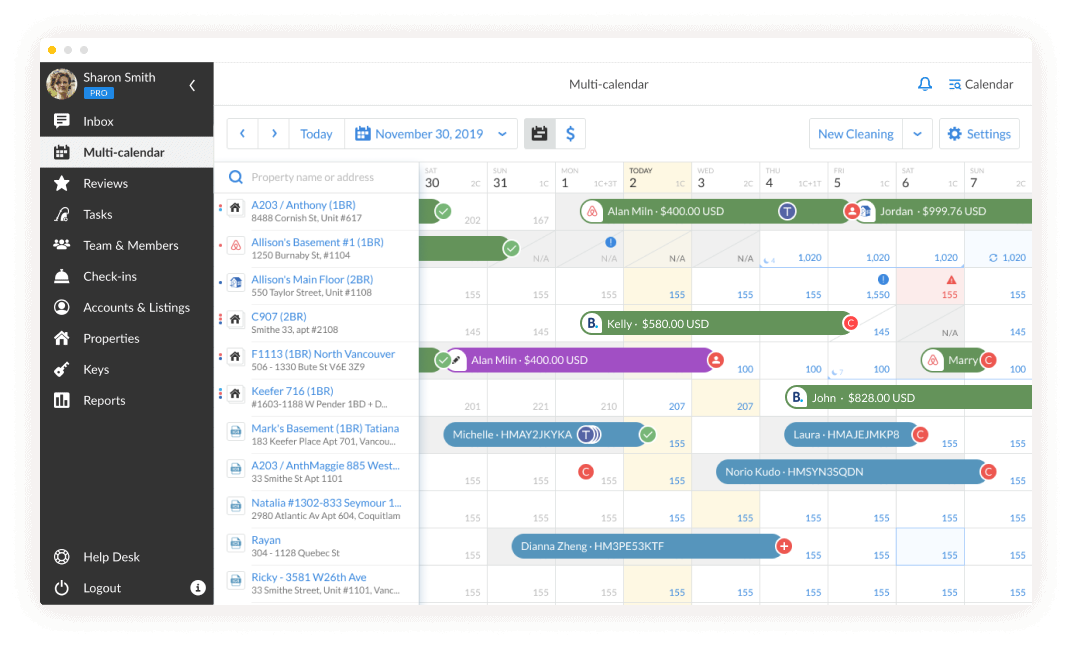 iGMS multi-calendar dashboard
iGMS multi-calendar dashboard
Features: The functionality pack contains the good old multi-calendar to track all the reservations, tasks, and check-ins and checkouts. The platform also provides an opportunity to automate messages, reviews, and notifications. You can run your rental business on the go with the IGMS mobile app. The channel manager and financial modules are also present within the platform.
Integrations: The iGMS channel manager provides API connections to Airbnb and Booking.com to handle all your listings and reservations. Unlike some other solutions, iGMS allows you to set up direct integrations to several Airbnb accounts, which can be helpful for property managers who use different profiles to list different properties. Other OTAs including TripAdvisor and Expedia can be integrated via iCal connection.
Pricing: Under the annual subscription, you have two options: Flex and Pro pricing plans. The first requires you to pay a fixed fee per booking ($1 per booked night). With the Pro package, you pay $18 per property per month.
Best for: Professional property managers who prefer using Airbnb are the best candidates for this solution.
Escapia: Vacation rental software with attractive and clear pricing
Founded in the US, Escapia is a cloud-based vacation rental software that helps market, manage, and maintain from 10 to 50 properties. With integrations, there can be more properties. Acquired by the world's leading online vacation rental marketplace HomeAway, Inc., which includes Vrbo, Escapia extended its suite and became one of the industry's most-used software as a service (SaaS) solutions. According to the provider, more than 900 property management companies around the world use their software.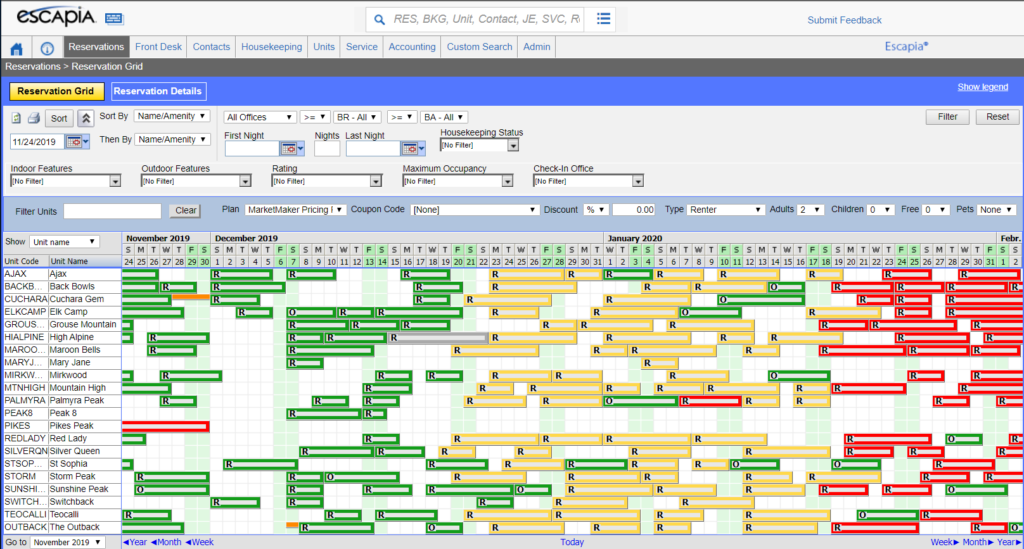
Escapia reservations dashboard
Features: Escapia can be considered a one-stop solution with all the features a property manager needs. The software has both a built-in channel manager and provides an opportunity to integrate stand-alone channel managers like Rental United, NextPex, and BookingPal. Escapia has a booking engine, central reservation system, unified inbox, mobile app, calendar, analytics tools (both built-in and those that can be integrated), and more. There’s also a convenient owner portal where they can book stays and monitor performance.
Integrations: Escapia has a network of over 75 trusted channel and business partners to facilitate operations and improve functionality. It has direct connections to Vrbo, FlipKey, Exotic Estates, and a bunch of other channels. Besides that, Escapia allows you to integrate home automation services and smart locks and keyless entry solutions.
Pricing: With Escapia, you pay $9 per month per property. You pay a flat monthly fee based on the number of properties per month. This PMS charges neither fees for booking nor additional costs for listing on Vrbo. That allows you to plan your expenses in advance with no unpleasant surprises. Pricing is what is attractive about Escapia.
Best for: Small to midsize rental owners who want a powerful solution at a price they can predict.
Track Vacation Rental PMS: Enterprise-size PMS provider for vacation rentals
Powered by Travel Net Solutions (TNS), Track PMS is a property management platform that can help automate a plethora of daily operational and communication tasks for those who manage more than 50 rental units. The option can be deployed as a cloud-based, web-based, or SaaS solution. It also has apps for Windows, Android, and iOS devices.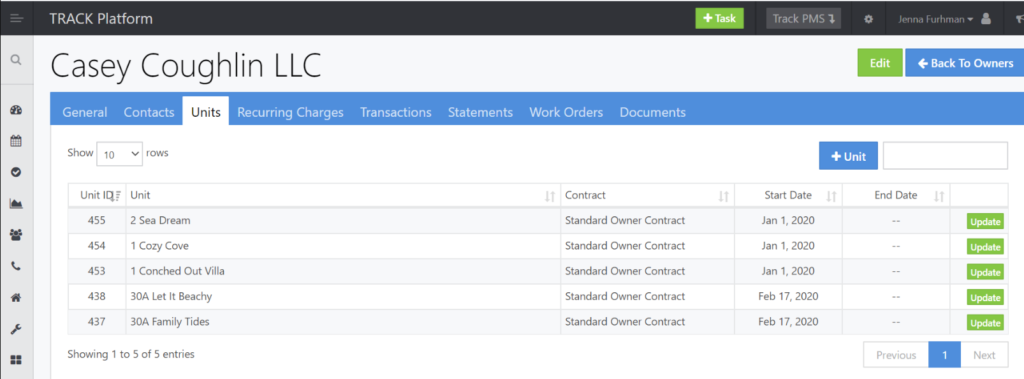
Owner portal at Track PMS
Features: Track PMS has an integrated channel manager with direct distribution to various online travel platforms. An accounting module allows for managing taxes and payments with ease from one location. Among other features find an integrated direct booking engine, guest and owner portals, and a rate management module. The core module of the system is a hospitality CRM where guest records are updated automatically so that the front and back office are on the same page.
Integrations: Apart from multiple software integration partners and direct connections, Track PMS offers a bunch of opportunities to connect to third-party vendors so that property managers can get all needed services. It integrates with Vrbo, Airbnb, Breezeway, and Home to Go, to name a few. The full list of available integrations can be found on their page.
Pricing: The provider doesn’t provide any pricing details but you can book a demo to get acquainted with what they offer.
Best for: Track PMS is a good fit for businesses that run 50+ rental units and want to have a wide array of integration options.
Rental APIs to integrate with major distribution channels
In case you have an in-house IT team and want to build your own vacation rental software or integrate the existing solution with the main booking channels, you won’t want to do without an API — a software mediator that enables different applications to communicate. Here, we highlight the top 3 rental APIs that you may want to have in your platform’s connection list.
Airbnb API
Airbnb is an online marketplace that allows property owners and other users to rent out their accommodations to travelers. The Airbnb API allows users to connect their software to the Airbnb platform. Development teams can create new applications with it. Airbnb has the REST (Representational State Transfer) architectural style and supports JSON request and response formats. It provides the following functionality:
- importing your data to Airbnb,
- syncing data to existing and new listings,
- setting reservations,
- managing prices, and
- configuring messages.
So far, the Airbnb API isn’t publicly available. To access it, register in the service and become a partner first.
TripAdvisor API
TripAdvisor is the world’s largest travel platform offering a wide list of vacation rentals to travelers. Connecting to the content via TripAdvisor APIs will be beneficial for property owners in a bunch of ways.
TripAdvisor offers a range of connectivity solutions for its self-implemented and connectivity partners. The APIs include Hotel Availability Check API, Instant Booking API, Review Express API, and TripConnect Campaign Data API that can be set up quickly and easily.
With TripAdvisor APIs, you will be able to
- view business performance on the platform,
- show rental availability and actual prices,
- get customer/billing info once they make a reservation on TripAdvisor,
- send emails requesting reviews, and
- retrieve a listing of campaign details for each mapped location.
Connecting to TripAdvisor grants access to other members of its family, namely FlipKey.
Vrbo API
Vrbo stands for “vacation rentals by owner,” which says it all about the company. It is a US-based vacation rental online marketplace that was acquired by another marketplace — HomeAway — in 2006. The two solutions were eventually acquired by Expedia Group, the world’s leading travel platform, having left the Vrbo name. As the brand resides under the roof of Expedia, it can be accessed via the Partner Solutions API named EPS Rapid. RESTful API capabilities are built into EPS Rapid for Vrbo supply. The API allows for
- getting information on vacation home rental listings on Vrbo, including rates and availability;
- accessing accounts;
- setting reservations and managing them; and
- defining payment options.
Interested in APIs? You can learn more in our dedicated article describing travel and booking APIs in detail.
Key things to consider when choosing software for a vacation rental business
The choice of vacation rental software greatly depends on your business type, size, and growth plans. From all of the above, you can see that different solutions offer a different stack of functional modules required for property management tasks. While the decision and the path leading to it are individual, below you will find a few tips aimed at facilitating the selection process.
Plan on the feature scope in advance
When you step onto the road of picking software, the first thing to keep in mind is that the system has just enough functionality in place — no more and no less. In simple words, if you rent out only a couple of properties, there’s no need to purchase a complex solution fully loaded with all possible modules. It's highly likely that you won’t use all the features and will end up overspending.
Ensure that your software has required integrations
Most vacation rental property management systems have built-in integrations to the most popular booking listings and rental websites like Booking.com, Vrbo, and Airbnb. But these platforms may not be the only ones you’re planning to use. So, it is a good idea to make an exhaustive list of all websites that carry value for your vacation rental business and check if there are integrations to these resources.
Join the mobile-friendly side
What device do you use when searching for something on the Internet? Bet it's your smartphone. The truth is, nearly 60 percent of all search volume belongs to the mobile share. There’s a decent chance that your potential renters also use their smartphones to find a suitable rental for their vacation. So, you need to ensure that your software is mobile-friendly to get the most of it.
Test the waters
While it may be self-evident, you should always ask for a demo before actually buying a software solution. These days, most providers offer free 7-day or 14-day trials so that customers can see the functional side in action.
Consider the size of properties you manage
They say it’s not that size that matters but the way you can cope with what you have. Unfortunately, it isn’t the case with the short-term rental business.
Vacation rental PMS adoption. Source: The Global Short-Term Rental Tech Report 2020: Stats, Trends and Investment by Rentals United
The chart above shows that the number of rental properties influences the choice of a property management system or the absence of one. The correlation is as follows: The greater the number of properties managed, the higher the percentage of those who choose to build their own property management system instead of using an off-the-shelf solution. So, if you are a big player running a business with more than 500, consider opting for custom software development that will be tailored to all your needs.
One of the main reasons for building tech in-house still remains a lack of third-party tools in certain fields and a need for customized solutions.
Be aware of the pricing
As shown above, PMSs provide different pricing options. And the one that is suitable for small businesses can be unprofitable for a bigger one. The money criterion should be taken into account when choosing vacation rental software. In many cases, a flat rate is more affordable for larger companies while smaller rental owners may be better off paying a commission-based rate.

